Western Sydney University Qualitative Study Appraisal Assignment
VerifiedAdded on 2022/09/07
|6
|2802
|13
Homework Assignment
AI Summary
This assignment presents a comprehensive critical appraisal of a qualitative study, focusing on the feasibility and acceptability of a nurse-led hypertension management intervention. The student meticulously analyzes a peer-reviewed journal article, addressing ontological, epistemological, methodological, and ethical questions. The appraisal evaluates the study's rigour, trustworthiness, and reporting of results, including the clarity of the research question, appropriateness of the qualitative design, sampling methods, data collection and analysis techniques, and the presentation of findings. The analysis incorporates at least three additional references to substantiate the arguments and findings. The student critically examines the congruity between the philosophical perspective, research methodology, and results, while also assessing the limitations of the study and the representation of participant voices. The assignment demonstrates an understanding of qualitative research principles and the ability to evaluate research quality, contributing to the development of skills essential for future healthcare practice and research endeavors.
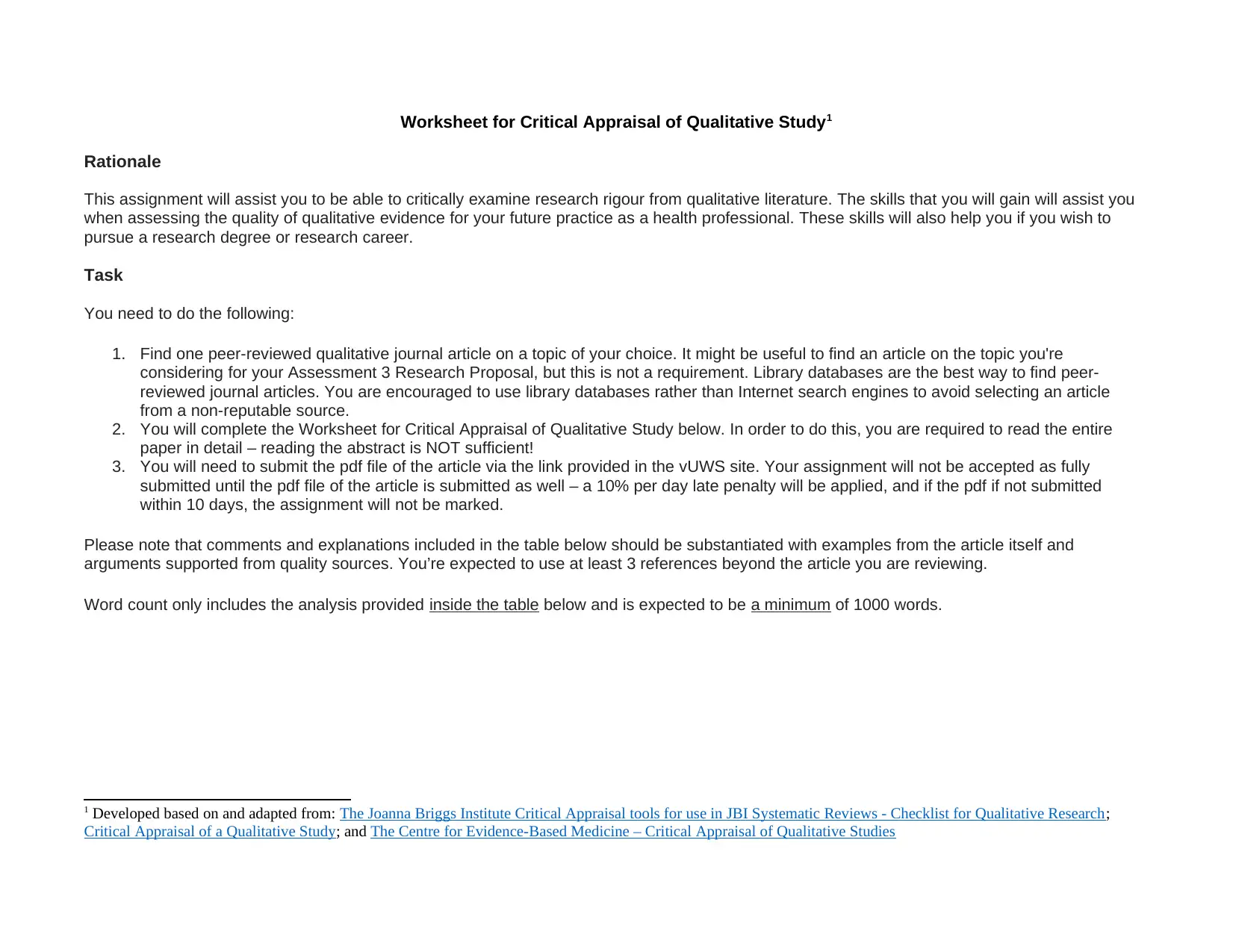
Worksheet for Critical Appraisal of Qualitative Study1
Rationale
This assignment will assist you to be able to critically examine research rigour from qualitative literature. The skills that you will gain will assist you
when assessing the quality of qualitative evidence for your future practice as a health professional. These skills will also help you if you wish to
pursue a research degree or research career.
Task
You need to do the following:
1. Find one peer-reviewed qualitative journal article on a topic of your choice. It might be useful to find an article on the topic you're
considering for your Assessment 3 Research Proposal, but this is not a requirement. Library databases are the best way to find peer-
reviewed journal articles. You are encouraged to use library databases rather than Internet search engines to avoid selecting an article
from a non-reputable source.
2. You will complete the Worksheet for Critical Appraisal of Qualitative Study below. In order to do this, you are required to read the entire
paper in detail – reading the abstract is NOT sufficient!
3. You will need to submit the pdf file of the article via the link provided in the vUWS site. Your assignment will not be accepted as fully
submitted until the pdf file of the article is submitted as well – a 10% per day late penalty will be applied, and if the pdf if not submitted
within 10 days, the assignment will not be marked.
Please note that comments and explanations included in the table below should be substantiated with examples from the article itself and
arguments supported from quality sources. You’re expected to use at least 3 references beyond the article you are reviewing.
Word count only includes the analysis provided inside the table below and is expected to be a minimum of 1000 words.
1 Developed based on and adapted from: The Joanna Briggs Institute Critical Appraisal tools for use in JBI Systematic Reviews - Checklist for Qualitative Research;
Critical Appraisal of a Qualitative Study; and The Centre for Evidence-Based Medicine – Critical Appraisal of Qualitative Studies
Rationale
This assignment will assist you to be able to critically examine research rigour from qualitative literature. The skills that you will gain will assist you
when assessing the quality of qualitative evidence for your future practice as a health professional. These skills will also help you if you wish to
pursue a research degree or research career.
Task
You need to do the following:
1. Find one peer-reviewed qualitative journal article on a topic of your choice. It might be useful to find an article on the topic you're
considering for your Assessment 3 Research Proposal, but this is not a requirement. Library databases are the best way to find peer-
reviewed journal articles. You are encouraged to use library databases rather than Internet search engines to avoid selecting an article
from a non-reputable source.
2. You will complete the Worksheet for Critical Appraisal of Qualitative Study below. In order to do this, you are required to read the entire
paper in detail – reading the abstract is NOT sufficient!
3. You will need to submit the pdf file of the article via the link provided in the vUWS site. Your assignment will not be accepted as fully
submitted until the pdf file of the article is submitted as well – a 10% per day late penalty will be applied, and if the pdf if not submitted
within 10 days, the assignment will not be marked.
Please note that comments and explanations included in the table below should be substantiated with examples from the article itself and
arguments supported from quality sources. You’re expected to use at least 3 references beyond the article you are reviewing.
Word count only includes the analysis provided inside the table below and is expected to be a minimum of 1000 words.
1 Developed based on and adapted from: The Joanna Briggs Institute Critical Appraisal tools for use in JBI Systematic Reviews - Checklist for Qualitative Research;
Critical Appraisal of a Qualitative Study; and The Centre for Evidence-Based Medicine – Critical Appraisal of Qualitative Studies
Paraphrase This Document
Need a fresh take? Get an instant paraphrase of this document with our AI Paraphraser
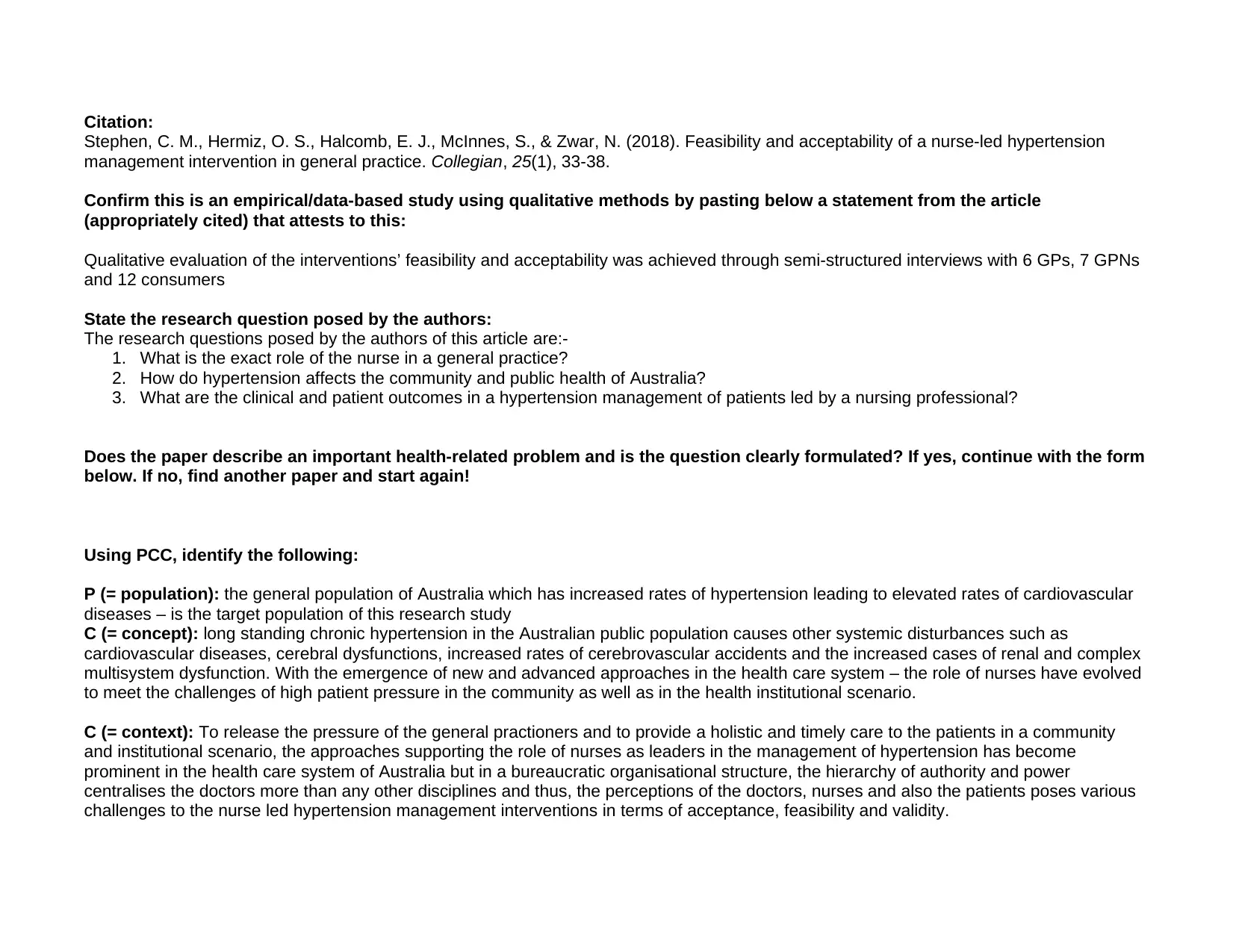
Citation:
Stephen, C. M., Hermiz, O. S., Halcomb, E. J., McInnes, S., & Zwar, N. (2018). Feasibility and acceptability of a nurse-led hypertension
management intervention in general practice. Collegian, 25(1), 33-38.
Confirm this is an empirical/data-based study using qualitative methods by pasting below a statement from the article
(appropriately cited) that attests to this:
Qualitative evaluation of the interventions’ feasibility and acceptability was achieved through semi-structured interviews with 6 GPs, 7 GPNs
and 12 consumers
State the research question posed by the authors:
The research questions posed by the authors of this article are:-
1. What is the exact role of the nurse in a general practice?
2. How do hypertension affects the community and public health of Australia?
3. What are the clinical and patient outcomes in a hypertension management of patients led by a nursing professional?
Does the paper describe an important health-related problem and is the question clearly formulated? If yes, continue with the form
below. If no, find another paper and start again!
Using PCC, identify the following:
P (= population): the general population of Australia which has increased rates of hypertension leading to elevated rates of cardiovascular
diseases – is the target population of this research study
C (= concept): long standing chronic hypertension in the Australian public population causes other systemic disturbances such as
cardiovascular diseases, cerebral dysfunctions, increased rates of cerebrovascular accidents and the increased cases of renal and complex
multisystem dysfunction. With the emergence of new and advanced approaches in the health care system – the role of nurses have evolved
to meet the challenges of high patient pressure in the community as well as in the health institutional scenario.
C (= context): To release the pressure of the general practioners and to provide a holistic and timely care to the patients in a community
and institutional scenario, the approaches supporting the role of nurses as leaders in the management of hypertension has become
prominent in the health care system of Australia but in a bureaucratic organisational structure, the hierarchy of authority and power
centralises the doctors more than any other disciplines and thus, the perceptions of the doctors, nurses and also the patients poses various
challenges to the nurse led hypertension management interventions in terms of acceptance, feasibility and validity.
Stephen, C. M., Hermiz, O. S., Halcomb, E. J., McInnes, S., & Zwar, N. (2018). Feasibility and acceptability of a nurse-led hypertension
management intervention in general practice. Collegian, 25(1), 33-38.
Confirm this is an empirical/data-based study using qualitative methods by pasting below a statement from the article
(appropriately cited) that attests to this:
Qualitative evaluation of the interventions’ feasibility and acceptability was achieved through semi-structured interviews with 6 GPs, 7 GPNs
and 12 consumers
State the research question posed by the authors:
The research questions posed by the authors of this article are:-
1. What is the exact role of the nurse in a general practice?
2. How do hypertension affects the community and public health of Australia?
3. What are the clinical and patient outcomes in a hypertension management of patients led by a nursing professional?
Does the paper describe an important health-related problem and is the question clearly formulated? If yes, continue with the form
below. If no, find another paper and start again!
Using PCC, identify the following:
P (= population): the general population of Australia which has increased rates of hypertension leading to elevated rates of cardiovascular
diseases – is the target population of this research study
C (= concept): long standing chronic hypertension in the Australian public population causes other systemic disturbances such as
cardiovascular diseases, cerebral dysfunctions, increased rates of cerebrovascular accidents and the increased cases of renal and complex
multisystem dysfunction. With the emergence of new and advanced approaches in the health care system – the role of nurses have evolved
to meet the challenges of high patient pressure in the community as well as in the health institutional scenario.
C (= context): To release the pressure of the general practioners and to provide a holistic and timely care to the patients in a community
and institutional scenario, the approaches supporting the role of nurses as leaders in the management of hypertension has become
prominent in the health care system of Australia but in a bureaucratic organisational structure, the hierarchy of authority and power
centralises the doctors more than any other disciplines and thus, the perceptions of the doctors, nurses and also the patients poses various
challenges to the nurse led hypertension management interventions in terms of acceptance, feasibility and validity.
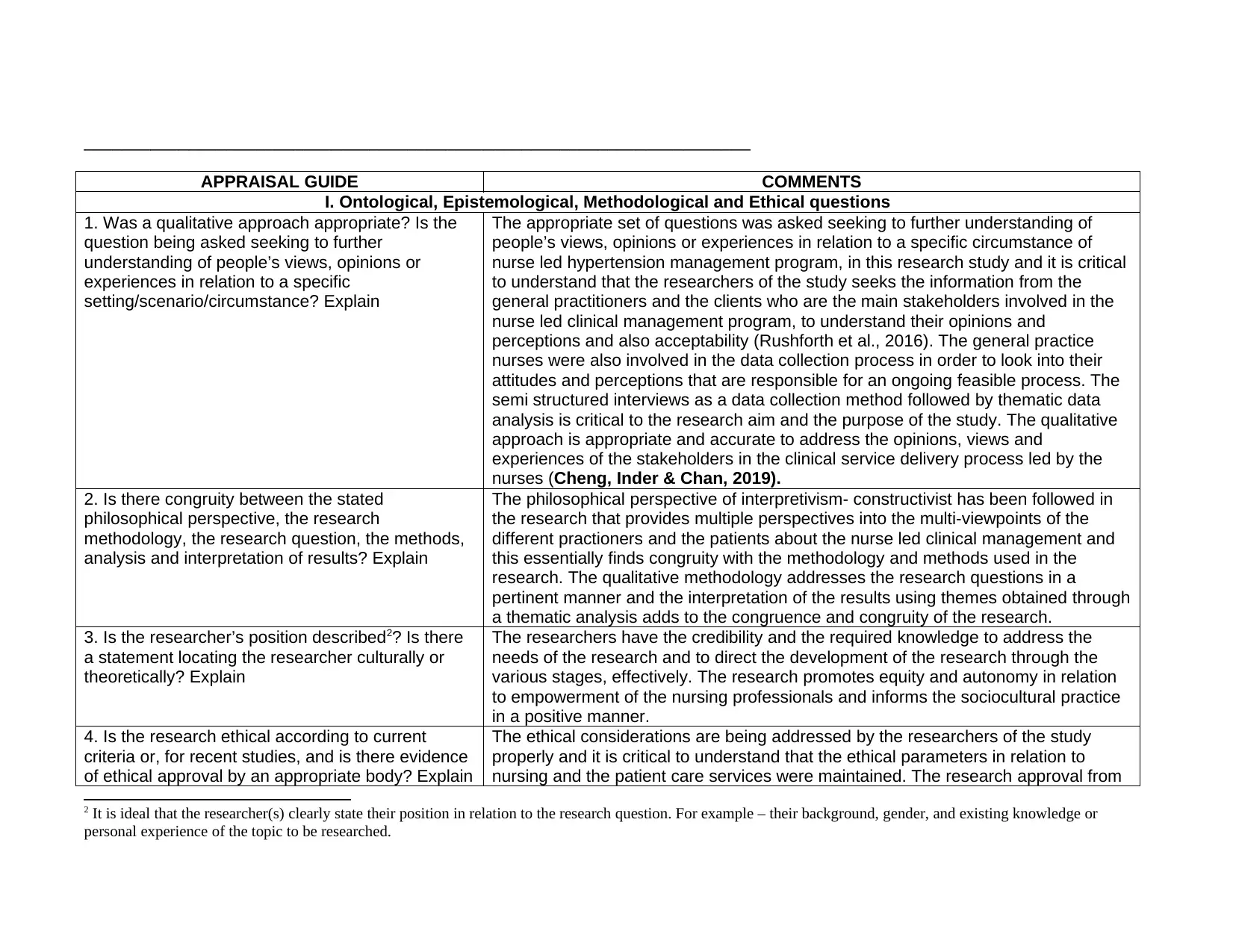
______________________________________________________________________
APPRAISAL GUIDE COMMENTS
I. Ontological, Epistemological, Methodological and Ethical questions
1. Was a qualitative approach appropriate? Is the
question being asked seeking to further
understanding of people’s views, opinions or
experiences in relation to a specific
setting/scenario/circumstance? Explain
The appropriate set of questions was asked seeking to further understanding of
people’s views, opinions or experiences in relation to a specific circumstance of
nurse led hypertension management program, in this research study and it is critical
to understand that the researchers of the study seeks the information from the
general practitioners and the clients who are the main stakeholders involved in the
nurse led clinical management program, to understand their opinions and
perceptions and also acceptability (Rushforth et al., 2016). The general practice
nurses were also involved in the data collection process in order to look into their
attitudes and perceptions that are responsible for an ongoing feasible process. The
semi structured interviews as a data collection method followed by thematic data
analysis is critical to the research aim and the purpose of the study. The qualitative
approach is appropriate and accurate to address the opinions, views and
experiences of the stakeholders in the clinical service delivery process led by the
nurses (Cheng, Inder & Chan, 2019).
2. Is there congruity between the stated
philosophical perspective, the research
methodology, the research question, the methods,
analysis and interpretation of results? Explain
The philosophical perspective of interpretivism- constructivist has been followed in
the research that provides multiple perspectives into the multi-viewpoints of the
different practioners and the patients about the nurse led clinical management and
this essentially finds congruity with the methodology and methods used in the
research. The qualitative methodology addresses the research questions in a
pertinent manner and the interpretation of the results using themes obtained through
a thematic analysis adds to the congruence and congruity of the research.
3. Is the researcher’s position described2? Is there
a statement locating the researcher culturally or
theoretically? Explain
The researchers have the credibility and the required knowledge to address the
needs of the research and to direct the development of the research through the
various stages, effectively. The research promotes equity and autonomy in relation
to empowerment of the nursing professionals and informs the sociocultural practice
in a positive manner.
4. Is the research ethical according to current
criteria or, for recent studies, and is there evidence
of ethical approval by an appropriate body? Explain
The ethical considerations are being addressed by the researchers of the study
properly and it is critical to understand that the ethical parameters in relation to
nursing and the patient care services were maintained. The research approval from
2 It is ideal that the researcher(s) clearly state their position in relation to the research question. For example – their background, gender, and existing knowledge or
personal experience of the topic to be researched.
APPRAISAL GUIDE COMMENTS
I. Ontological, Epistemological, Methodological and Ethical questions
1. Was a qualitative approach appropriate? Is the
question being asked seeking to further
understanding of people’s views, opinions or
experiences in relation to a specific
setting/scenario/circumstance? Explain
The appropriate set of questions was asked seeking to further understanding of
people’s views, opinions or experiences in relation to a specific circumstance of
nurse led hypertension management program, in this research study and it is critical
to understand that the researchers of the study seeks the information from the
general practitioners and the clients who are the main stakeholders involved in the
nurse led clinical management program, to understand their opinions and
perceptions and also acceptability (Rushforth et al., 2016). The general practice
nurses were also involved in the data collection process in order to look into their
attitudes and perceptions that are responsible for an ongoing feasible process. The
semi structured interviews as a data collection method followed by thematic data
analysis is critical to the research aim and the purpose of the study. The qualitative
approach is appropriate and accurate to address the opinions, views and
experiences of the stakeholders in the clinical service delivery process led by the
nurses (Cheng, Inder & Chan, 2019).
2. Is there congruity between the stated
philosophical perspective, the research
methodology, the research question, the methods,
analysis and interpretation of results? Explain
The philosophical perspective of interpretivism- constructivist has been followed in
the research that provides multiple perspectives into the multi-viewpoints of the
different practioners and the patients about the nurse led clinical management and
this essentially finds congruity with the methodology and methods used in the
research. The qualitative methodology addresses the research questions in a
pertinent manner and the interpretation of the results using themes obtained through
a thematic analysis adds to the congruence and congruity of the research.
3. Is the researcher’s position described2? Is there
a statement locating the researcher culturally or
theoretically? Explain
The researchers have the credibility and the required knowledge to address the
needs of the research and to direct the development of the research through the
various stages, effectively. The research promotes equity and autonomy in relation
to empowerment of the nursing professionals and informs the sociocultural practice
in a positive manner.
4. Is the research ethical according to current
criteria or, for recent studies, and is there evidence
of ethical approval by an appropriate body? Explain
The ethical considerations are being addressed by the researchers of the study
properly and it is critical to understand that the ethical parameters in relation to
nursing and the patient care services were maintained. The research approval from
2 It is ideal that the researcher(s) clearly state their position in relation to the research question. For example – their background, gender, and existing knowledge or
personal experience of the topic to be researched.
⊘ This is a preview!⊘
Do you want full access?
Subscribe today to unlock all pages.

Trusted by 1+ million students worldwide
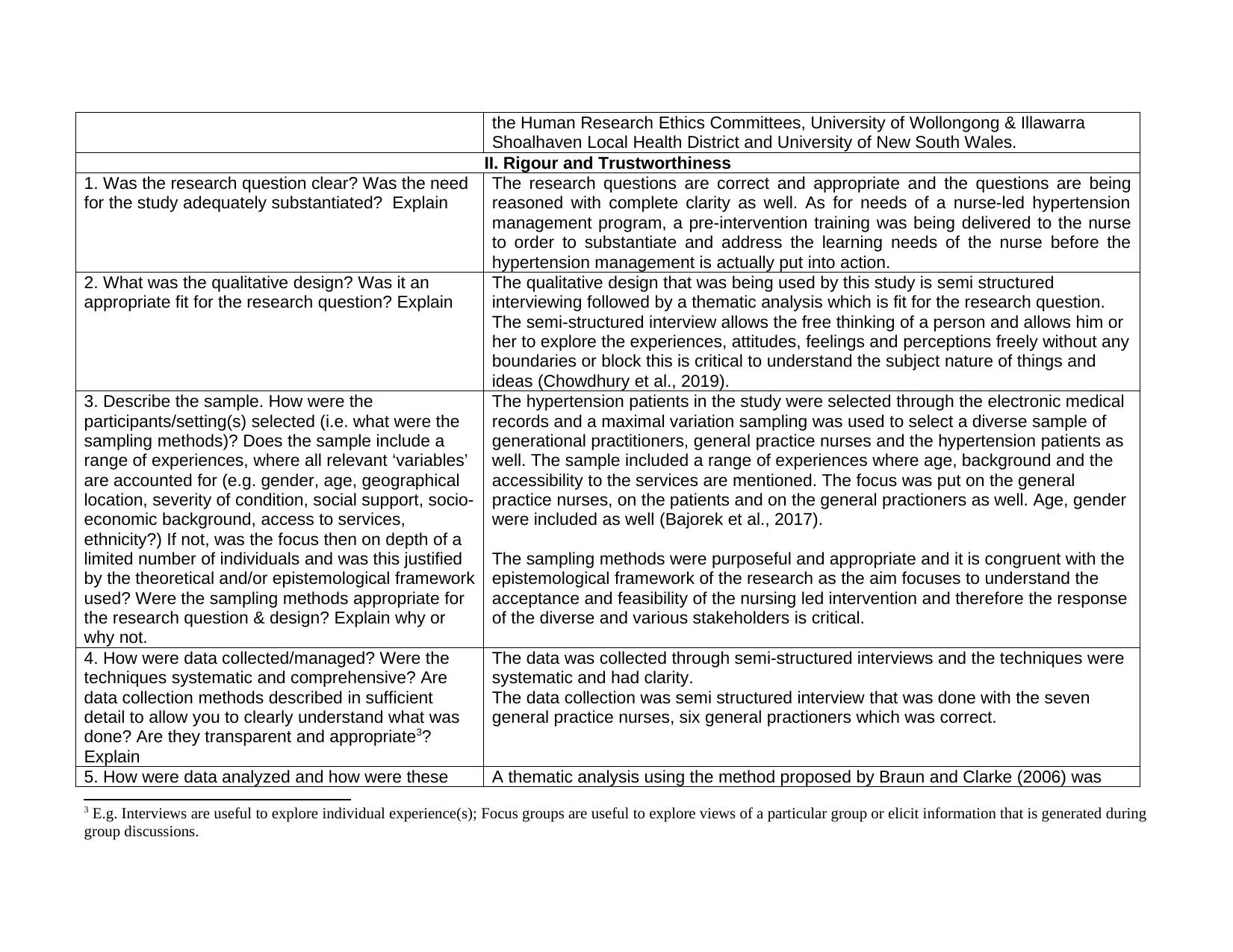
the Human Research Ethics Committees, University of Wollongong & Illawarra
Shoalhaven Local Health District and University of New South Wales.
II. Rigour and Trustworthiness
1. Was the research question clear? Was the need
for the study adequately substantiated? Explain
The research questions are correct and appropriate and the questions are being
reasoned with complete clarity as well. As for needs of a nurse-led hypertension
management program, a pre-intervention training was being delivered to the nurse
to order to substantiate and address the learning needs of the nurse before the
hypertension management is actually put into action.
2. What was the qualitative design? Was it an
appropriate fit for the research question? Explain
The qualitative design that was being used by this study is semi structured
interviewing followed by a thematic analysis which is fit for the research question.
The semi-structured interview allows the free thinking of a person and allows him or
her to explore the experiences, attitudes, feelings and perceptions freely without any
boundaries or block this is critical to understand the subject nature of things and
ideas (Chowdhury et al., 2019).
3. Describe the sample. How were the
participants/setting(s) selected (i.e. what were the
sampling methods)? Does the sample include a
range of experiences, where all relevant ‘variables’
are accounted for (e.g. gender, age, geographical
location, severity of condition, social support, socio-
economic background, access to services,
ethnicity?) If not, was the focus then on depth of a
limited number of individuals and was this justified
by the theoretical and/or epistemological framework
used? Were the sampling methods appropriate for
the research question & design? Explain why or
why not.
The hypertension patients in the study were selected through the electronic medical
records and a maximal variation sampling was used to select a diverse sample of
generational practitioners, general practice nurses and the hypertension patients as
well. The sample included a range of experiences where age, background and the
accessibility to the services are mentioned. The focus was put on the general
practice nurses, on the patients and on the general practioners as well. Age, gender
were included as well (Bajorek et al., 2017).
The sampling methods were purposeful and appropriate and it is congruent with the
epistemological framework of the research as the aim focuses to understand the
acceptance and feasibility of the nursing led intervention and therefore the response
of the diverse and various stakeholders is critical.
4. How were data collected/managed? Were the
techniques systematic and comprehensive? Are
data collection methods described in sufficient
detail to allow you to clearly understand what was
done? Are they transparent and appropriate3?
Explain
The data was collected through semi-structured interviews and the techniques were
systematic and had clarity.
The data collection was semi structured interview that was done with the seven
general practice nurses, six general practioners which was correct.
5. How were data analyzed and how were these A thematic analysis using the method proposed by Braun and Clarke (2006) was
3 E.g. Interviews are useful to explore individual experience(s); Focus groups are useful to explore views of a particular group or elicit information that is generated during
group discussions.
Shoalhaven Local Health District and University of New South Wales.
II. Rigour and Trustworthiness
1. Was the research question clear? Was the need
for the study adequately substantiated? Explain
The research questions are correct and appropriate and the questions are being
reasoned with complete clarity as well. As for needs of a nurse-led hypertension
management program, a pre-intervention training was being delivered to the nurse
to order to substantiate and address the learning needs of the nurse before the
hypertension management is actually put into action.
2. What was the qualitative design? Was it an
appropriate fit for the research question? Explain
The qualitative design that was being used by this study is semi structured
interviewing followed by a thematic analysis which is fit for the research question.
The semi-structured interview allows the free thinking of a person and allows him or
her to explore the experiences, attitudes, feelings and perceptions freely without any
boundaries or block this is critical to understand the subject nature of things and
ideas (Chowdhury et al., 2019).
3. Describe the sample. How were the
participants/setting(s) selected (i.e. what were the
sampling methods)? Does the sample include a
range of experiences, where all relevant ‘variables’
are accounted for (e.g. gender, age, geographical
location, severity of condition, social support, socio-
economic background, access to services,
ethnicity?) If not, was the focus then on depth of a
limited number of individuals and was this justified
by the theoretical and/or epistemological framework
used? Were the sampling methods appropriate for
the research question & design? Explain why or
why not.
The hypertension patients in the study were selected through the electronic medical
records and a maximal variation sampling was used to select a diverse sample of
generational practitioners, general practice nurses and the hypertension patients as
well. The sample included a range of experiences where age, background and the
accessibility to the services are mentioned. The focus was put on the general
practice nurses, on the patients and on the general practioners as well. Age, gender
were included as well (Bajorek et al., 2017).
The sampling methods were purposeful and appropriate and it is congruent with the
epistemological framework of the research as the aim focuses to understand the
acceptance and feasibility of the nursing led intervention and therefore the response
of the diverse and various stakeholders is critical.
4. How were data collected/managed? Were the
techniques systematic and comprehensive? Are
data collection methods described in sufficient
detail to allow you to clearly understand what was
done? Are they transparent and appropriate3?
Explain
The data was collected through semi-structured interviews and the techniques were
systematic and had clarity.
The data collection was semi structured interview that was done with the seven
general practice nurses, six general practioners which was correct.
5. How were data analyzed and how were these A thematic analysis using the method proposed by Braun and Clarke (2006) was
3 E.g. Interviews are useful to explore individual experience(s); Focus groups are useful to explore views of a particular group or elicit information that is generated during
group discussions.
Paraphrase This Document
Need a fresh take? Get an instant paraphrase of this document with our AI Paraphraser
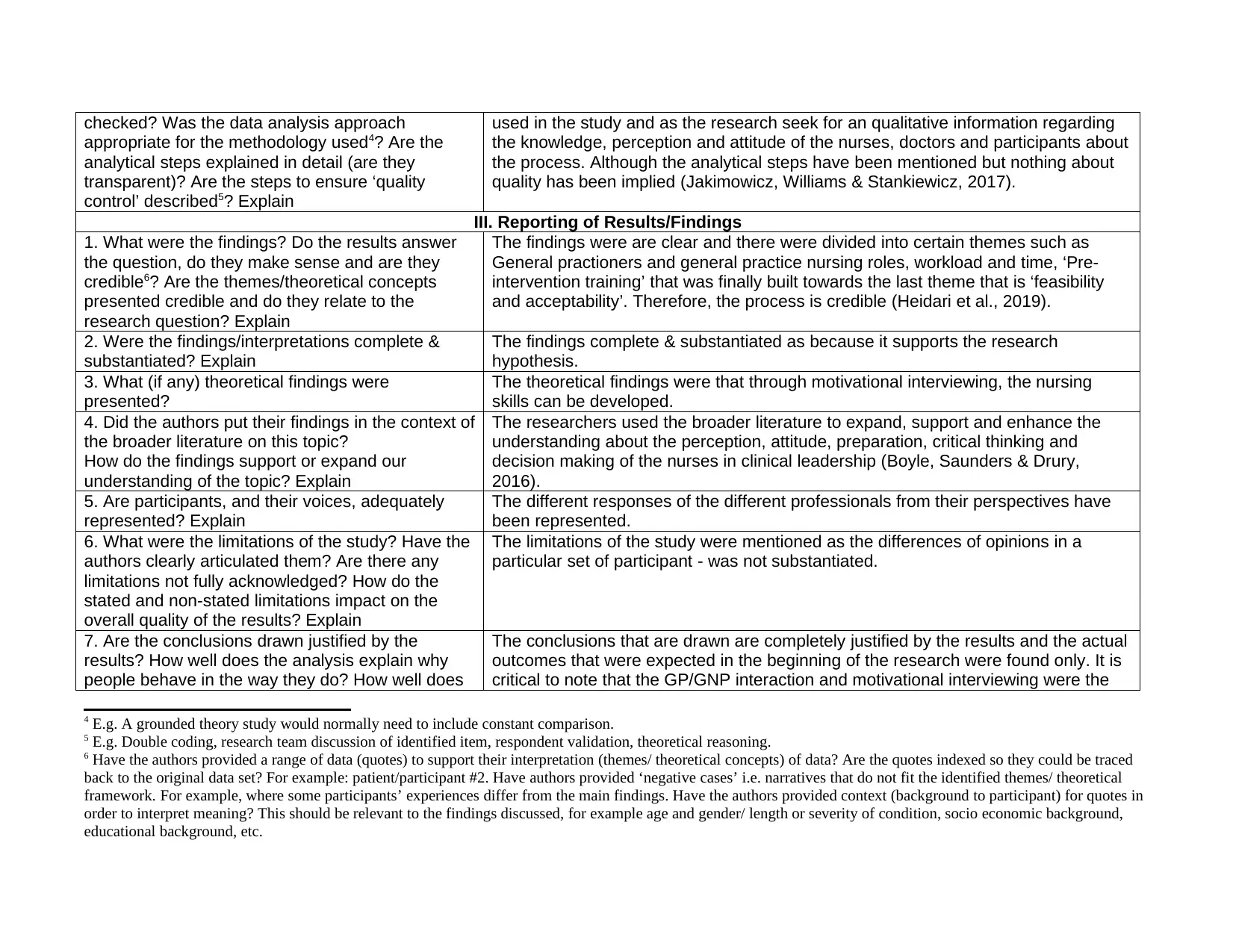
checked? Was the data analysis approach
appropriate for the methodology used4? Are the
analytical steps explained in detail (are they
transparent)? Are the steps to ensure ‘quality
control’ described5? Explain
used in the study and as the research seek for an qualitative information regarding
the knowledge, perception and attitude of the nurses, doctors and participants about
the process. Although the analytical steps have been mentioned but nothing about
quality has been implied (Jakimowicz, Williams & Stankiewicz, 2017).
III. Reporting of Results/Findings
1. What were the findings? Do the results answer
the question, do they make sense and are they
credible6? Are the themes/theoretical concepts
presented credible and do they relate to the
research question? Explain
The findings were are clear and there were divided into certain themes such as
General practioners and general practice nursing roles, workload and time, ‘Pre-
intervention training’ that was finally built towards the last theme that is ‘feasibility
and acceptability’. Therefore, the process is credible (Heidari et al., 2019).
2. Were the findings/interpretations complete &
substantiated? Explain
The findings complete & substantiated as because it supports the research
hypothesis.
3. What (if any) theoretical findings were
presented?
The theoretical findings were that through motivational interviewing, the nursing
skills can be developed.
4. Did the authors put their findings in the context of
the broader literature on this topic?
How do the findings support or expand our
understanding of the topic? Explain
The researchers used the broader literature to expand, support and enhance the
understanding about the perception, attitude, preparation, critical thinking and
decision making of the nurses in clinical leadership (Boyle, Saunders & Drury,
2016).
5. Are participants, and their voices, adequately
represented? Explain
The different responses of the different professionals from their perspectives have
been represented.
6. What were the limitations of the study? Have the
authors clearly articulated them? Are there any
limitations not fully acknowledged? How do the
stated and non-stated limitations impact on the
overall quality of the results? Explain
The limitations of the study were mentioned as the differences of opinions in a
particular set of participant - was not substantiated.
7. Are the conclusions drawn justified by the
results? How well does the analysis explain why
people behave in the way they do? How well does
The conclusions that are drawn are completely justified by the results and the actual
outcomes that were expected in the beginning of the research were found only. It is
critical to note that the GP/GNP interaction and motivational interviewing were the
4 E.g. A grounded theory study would normally need to include constant comparison.
5 E.g. Double coding, research team discussion of identified item, respondent validation, theoretical reasoning.
6 Have the authors provided a range of data (quotes) to support their interpretation (themes/ theoretical concepts) of data? Are the quotes indexed so they could be traced
back to the original data set? For example: patient/participant #2. Have authors provided ‘negative cases’ i.e. narratives that do not fit the identified themes/ theoretical
framework. For example, where some participants’ experiences differ from the main findings. Have the authors provided context (background to participant) for quotes in
order to interpret meaning? This should be relevant to the findings discussed, for example age and gender/ length or severity of condition, socio economic background,
educational background, etc.
appropriate for the methodology used4? Are the
analytical steps explained in detail (are they
transparent)? Are the steps to ensure ‘quality
control’ described5? Explain
used in the study and as the research seek for an qualitative information regarding
the knowledge, perception and attitude of the nurses, doctors and participants about
the process. Although the analytical steps have been mentioned but nothing about
quality has been implied (Jakimowicz, Williams & Stankiewicz, 2017).
III. Reporting of Results/Findings
1. What were the findings? Do the results answer
the question, do they make sense and are they
credible6? Are the themes/theoretical concepts
presented credible and do they relate to the
research question? Explain
The findings were are clear and there were divided into certain themes such as
General practioners and general practice nursing roles, workload and time, ‘Pre-
intervention training’ that was finally built towards the last theme that is ‘feasibility
and acceptability’. Therefore, the process is credible (Heidari et al., 2019).
2. Were the findings/interpretations complete &
substantiated? Explain
The findings complete & substantiated as because it supports the research
hypothesis.
3. What (if any) theoretical findings were
presented?
The theoretical findings were that through motivational interviewing, the nursing
skills can be developed.
4. Did the authors put their findings in the context of
the broader literature on this topic?
How do the findings support or expand our
understanding of the topic? Explain
The researchers used the broader literature to expand, support and enhance the
understanding about the perception, attitude, preparation, critical thinking and
decision making of the nurses in clinical leadership (Boyle, Saunders & Drury,
2016).
5. Are participants, and their voices, adequately
represented? Explain
The different responses of the different professionals from their perspectives have
been represented.
6. What were the limitations of the study? Have the
authors clearly articulated them? Are there any
limitations not fully acknowledged? How do the
stated and non-stated limitations impact on the
overall quality of the results? Explain
The limitations of the study were mentioned as the differences of opinions in a
particular set of participant - was not substantiated.
7. Are the conclusions drawn justified by the
results? How well does the analysis explain why
people behave in the way they do? How well does
The conclusions that are drawn are completely justified by the results and the actual
outcomes that were expected in the beginning of the research were found only. It is
critical to note that the GP/GNP interaction and motivational interviewing were the
4 E.g. A grounded theory study would normally need to include constant comparison.
5 E.g. Double coding, research team discussion of identified item, respondent validation, theoretical reasoning.
6 Have the authors provided a range of data (quotes) to support their interpretation (themes/ theoretical concepts) of data? Are the quotes indexed so they could be traced
back to the original data set? For example: patient/participant #2. Have authors provided ‘negative cases’ i.e. narratives that do not fit the identified themes/ theoretical
framework. For example, where some participants’ experiences differ from the main findings. Have the authors provided context (background to participant) for quotes in
order to interpret meaning? This should be relevant to the findings discussed, for example age and gender/ length or severity of condition, socio economic background,
educational background, etc.
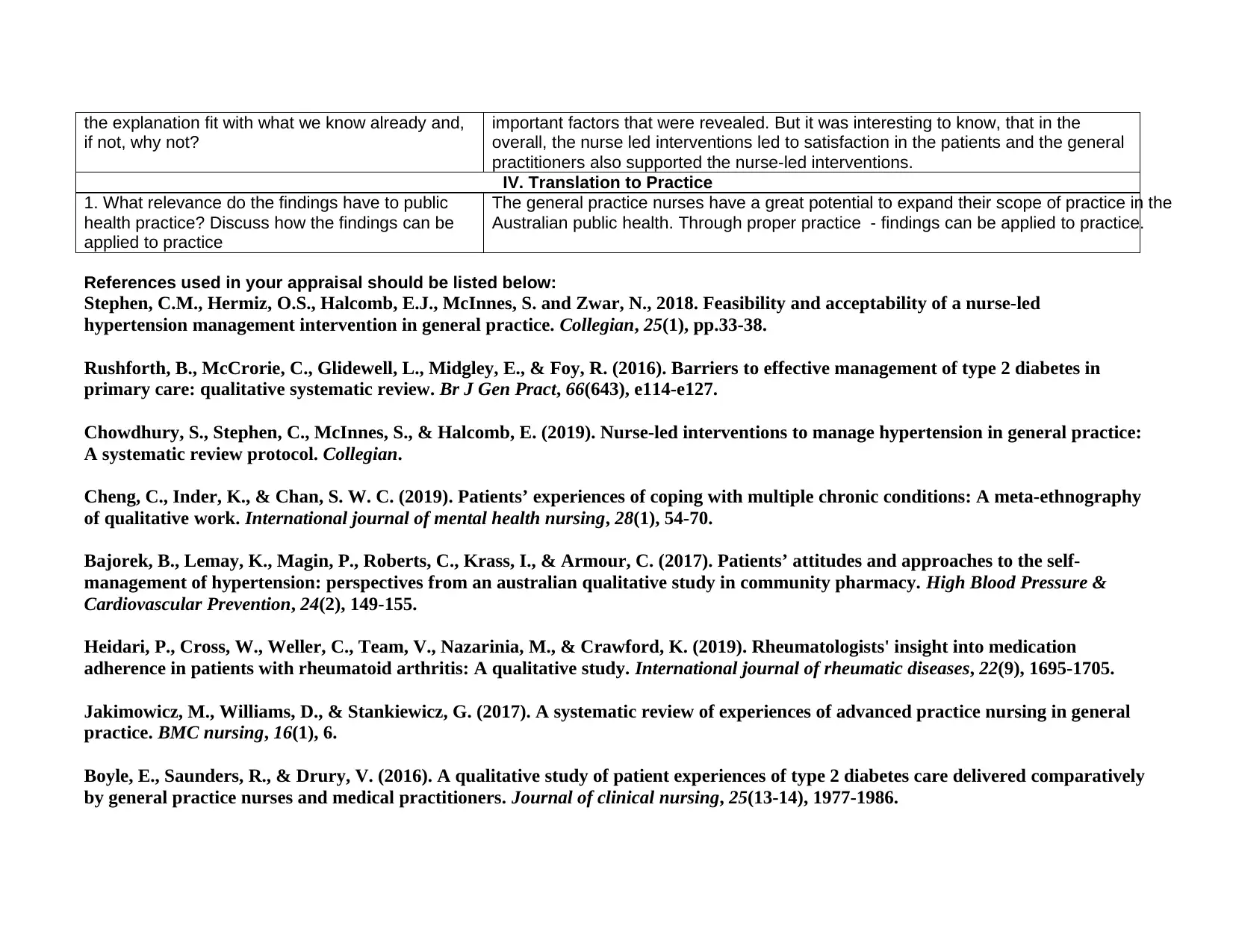
the explanation fit with what we know already and,
if not, why not?
important factors that were revealed. But it was interesting to know, that in the
overall, the nurse led interventions led to satisfaction in the patients and the general
practitioners also supported the nurse-led interventions.
IV. Translation to Practice
1. What relevance do the findings have to public
health practice? Discuss how the findings can be
applied to practice
The general practice nurses have a great potential to expand their scope of practice in the
Australian public health. Through proper practice - findings can be applied to practice.
References used in your appraisal should be listed below:
Stephen, C.M., Hermiz, O.S., Halcomb, E.J., McInnes, S. and Zwar, N., 2018. Feasibility and acceptability of a nurse-led
hypertension management intervention in general practice. Collegian, 25(1), pp.33-38.
Rushforth, B., McCrorie, C., Glidewell, L., Midgley, E., & Foy, R. (2016). Barriers to effective management of type 2 diabetes in
primary care: qualitative systematic review. Br J Gen Pract, 66(643), e114-e127.
Chowdhury, S., Stephen, C., McInnes, S., & Halcomb, E. (2019). Nurse-led interventions to manage hypertension in general practice:
A systematic review protocol. Collegian.
Cheng, C., Inder, K., & Chan, S. W. C. (2019). Patients’ experiences of coping with multiple chronic conditions: A meta‐ethnography
of qualitative work. International journal of mental health nursing, 28(1), 54-70.
Bajorek, B., Lemay, K., Magin, P., Roberts, C., Krass, I., & Armour, C. (2017). Patients’ attitudes and approaches to the self-
management of hypertension: perspectives from an australian qualitative study in community pharmacy. High Blood Pressure &
Cardiovascular Prevention, 24(2), 149-155.
Heidari, P., Cross, W., Weller, C., Team, V., Nazarinia, M., & Crawford, K. (2019). Rheumatologists' insight into medication
adherence in patients with rheumatoid arthritis: A qualitative study. International journal of rheumatic diseases, 22(9), 1695-1705.
Jakimowicz, M., Williams, D., & Stankiewicz, G. (2017). A systematic review of experiences of advanced practice nursing in general
practice. BMC nursing, 16(1), 6.
Boyle, E., Saunders, R., & Drury, V. (2016). A qualitative study of patient experiences of type 2 diabetes care delivered comparatively
by general practice nurses and medical practitioners. Journal of clinical nursing, 25(13-14), 1977-1986.
if not, why not?
important factors that were revealed. But it was interesting to know, that in the
overall, the nurse led interventions led to satisfaction in the patients and the general
practitioners also supported the nurse-led interventions.
IV. Translation to Practice
1. What relevance do the findings have to public
health practice? Discuss how the findings can be
applied to practice
The general practice nurses have a great potential to expand their scope of practice in the
Australian public health. Through proper practice - findings can be applied to practice.
References used in your appraisal should be listed below:
Stephen, C.M., Hermiz, O.S., Halcomb, E.J., McInnes, S. and Zwar, N., 2018. Feasibility and acceptability of a nurse-led
hypertension management intervention in general practice. Collegian, 25(1), pp.33-38.
Rushforth, B., McCrorie, C., Glidewell, L., Midgley, E., & Foy, R. (2016). Barriers to effective management of type 2 diabetes in
primary care: qualitative systematic review. Br J Gen Pract, 66(643), e114-e127.
Chowdhury, S., Stephen, C., McInnes, S., & Halcomb, E. (2019). Nurse-led interventions to manage hypertension in general practice:
A systematic review protocol. Collegian.
Cheng, C., Inder, K., & Chan, S. W. C. (2019). Patients’ experiences of coping with multiple chronic conditions: A meta‐ethnography
of qualitative work. International journal of mental health nursing, 28(1), 54-70.
Bajorek, B., Lemay, K., Magin, P., Roberts, C., Krass, I., & Armour, C. (2017). Patients’ attitudes and approaches to the self-
management of hypertension: perspectives from an australian qualitative study in community pharmacy. High Blood Pressure &
Cardiovascular Prevention, 24(2), 149-155.
Heidari, P., Cross, W., Weller, C., Team, V., Nazarinia, M., & Crawford, K. (2019). Rheumatologists' insight into medication
adherence in patients with rheumatoid arthritis: A qualitative study. International journal of rheumatic diseases, 22(9), 1695-1705.
Jakimowicz, M., Williams, D., & Stankiewicz, G. (2017). A systematic review of experiences of advanced practice nursing in general
practice. BMC nursing, 16(1), 6.
Boyle, E., Saunders, R., & Drury, V. (2016). A qualitative study of patient experiences of type 2 diabetes care delivered comparatively
by general practice nurses and medical practitioners. Journal of clinical nursing, 25(13-14), 1977-1986.
⊘ This is a preview!⊘
Do you want full access?
Subscribe today to unlock all pages.

Trusted by 1+ million students worldwide
1 out of 6
Related Documents
Your All-in-One AI-Powered Toolkit for Academic Success.
+13062052269
info@desklib.com
Available 24*7 on WhatsApp / Email
![[object Object]](/_next/static/media/star-bottom.7253800d.svg)
Unlock your academic potential
Copyright © 2020–2025 A2Z Services. All Rights Reserved. Developed and managed by ZUCOL.




